

It seems odd to conclude that managing the airflow around bottles is important, yet also assume a rider would only want one. Using two means moving the down tube bottle up so the upper portion is higher than the flare in the down tube. It’s a neat idea, though it appears to be optimised for only a single bottle cage placed low on the down tube. The down tube is home to only a single bottle cage. Up front, the nose of the bike extends forward like the bow of a ship, while the top of the down tube is shaped to capture the airflow off the chunky front tyre.Īround halfway, the down tube flares out again to help divert airflow around a water bottle. Once you learn legendary bike designer Gerard Vroomen was heavily involved in the design of both bikes, it makes sense. Though 3T doesn’t make any specific aero claims about the Strada ICR, it shares some of its visual DNA with Cervélo’s S5 (one of the best aero road bikes). Though the general concept remains the same, 3T says it has taken advantage of recent changes to the UCI’s technical regulations to make this latest version of the Strada even more aerodynamic.

The Strada ICR marks a fresh start, then. Though 3T eventually relented to demand and released a 2x-compatible version (the Strada Due), its reputation had been somewhat marred by an ill-fated attempt at 1x in the WorldTour. The original, 1x-only 3T Strada was both groundbreaking and something of a near miss. The Strada ICR is 3T’s third iteration of the Strada platform. 3T uses its own newly developed internal cable routing system.


 0 kommentar(er)
0 kommentar(er)
